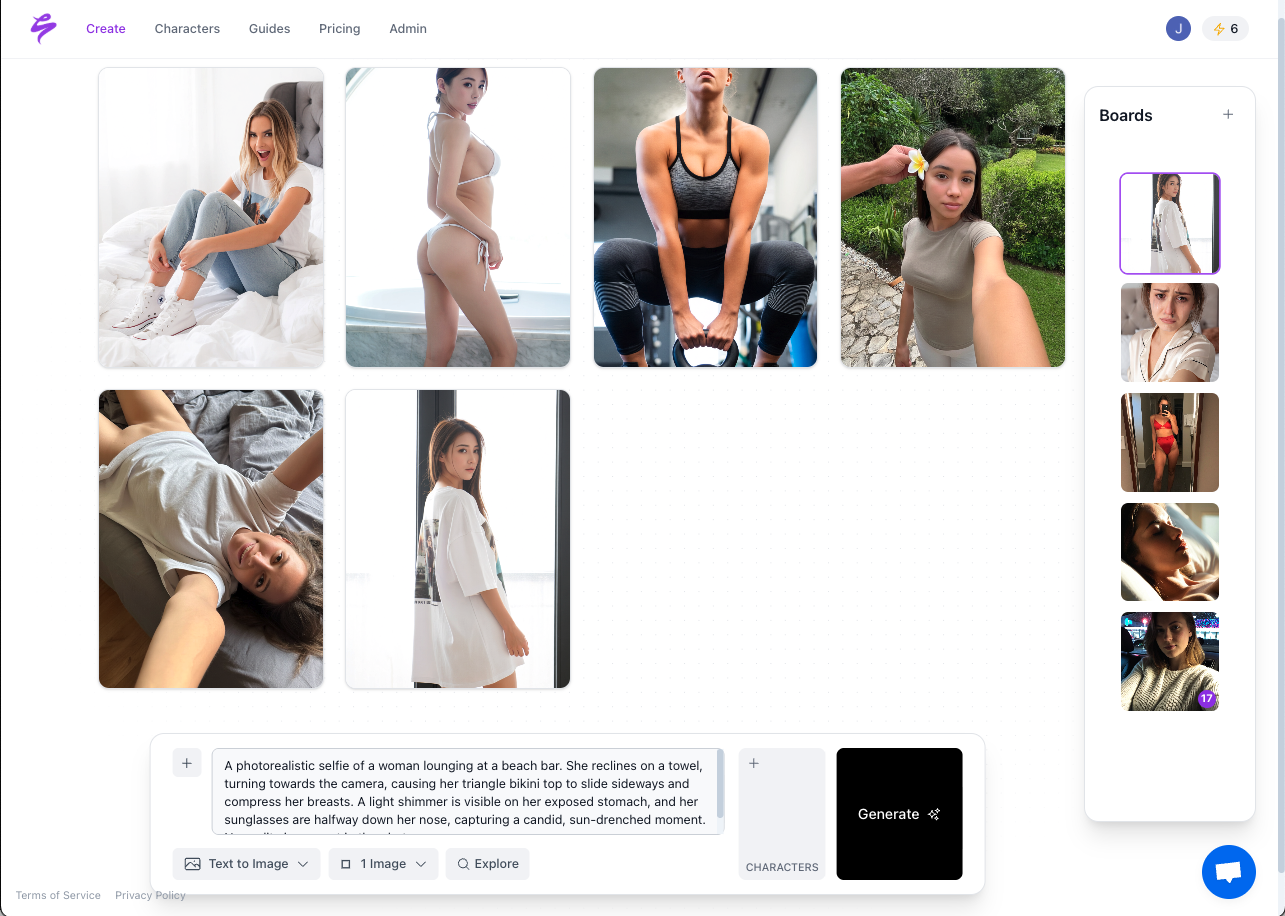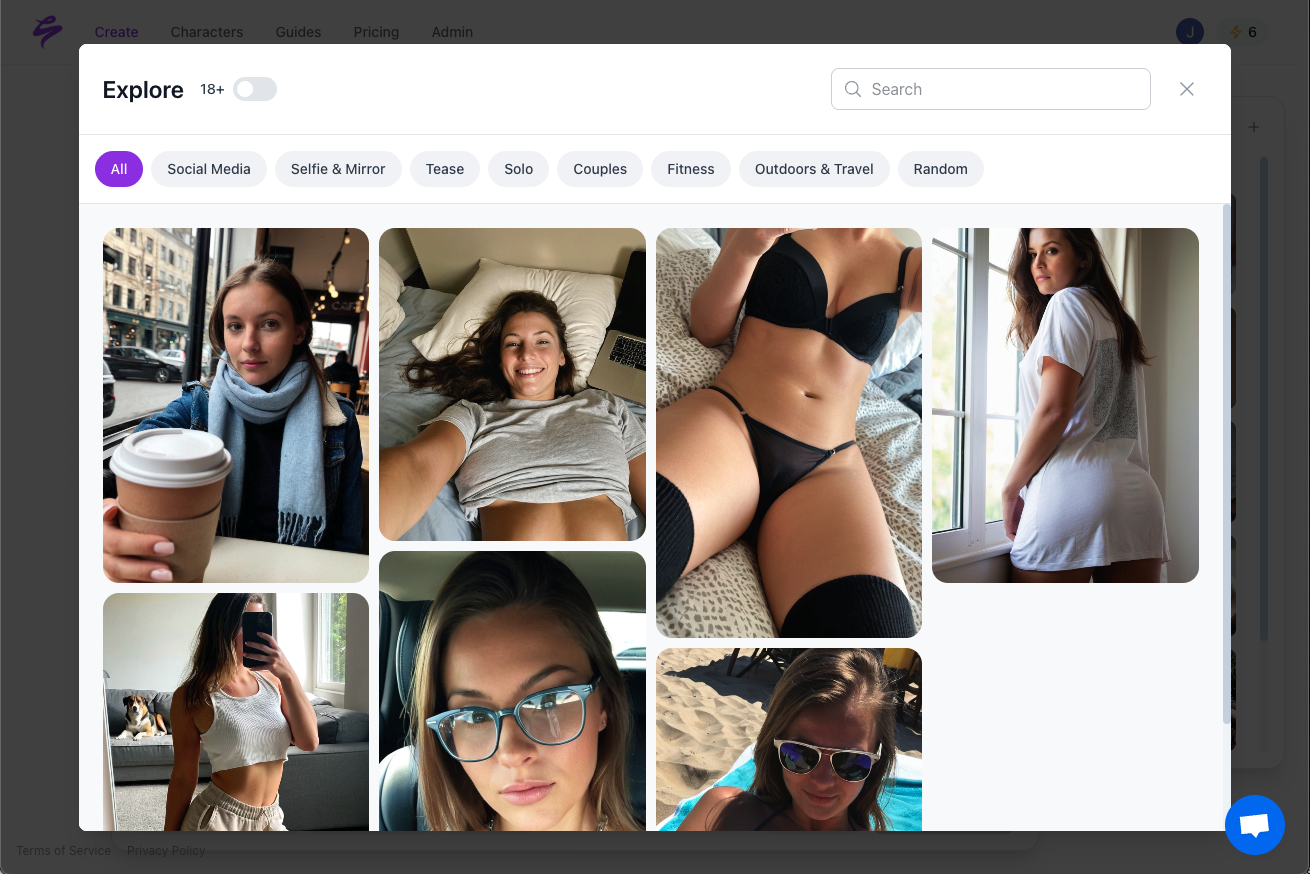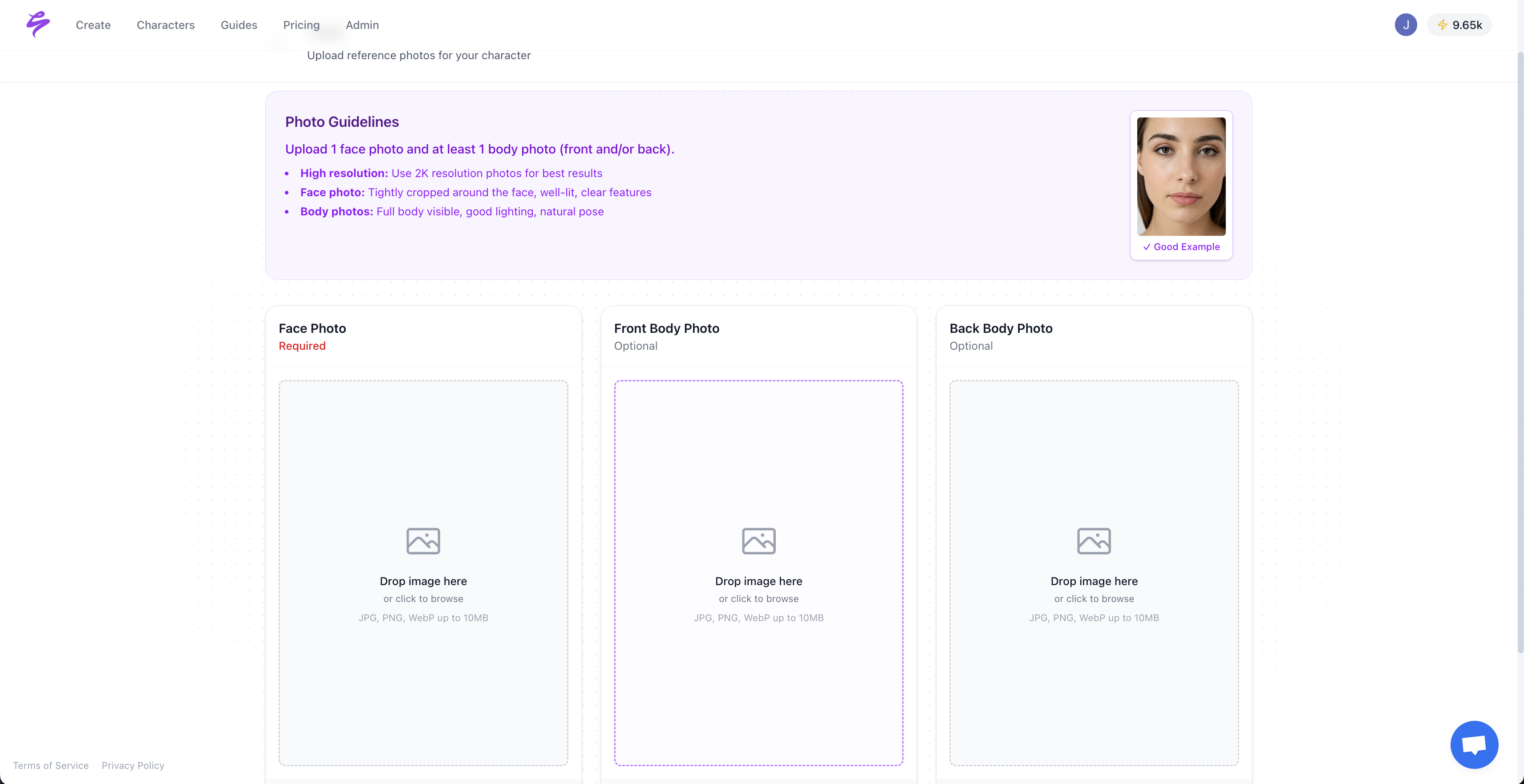Executive summary
- Privacy-focused AI content tools allow creators to scale output without exposing personal data or losing control of their likeness.
- Creator digital twins preserve brand authenticity and visual consistency across platforms while reducing production time and cost.
- Agencies and creators can stabilize revenue and simplify workflows by generating high-quality content on demand.
- Anonymous and niche creators gain new ways to grow safely with full control over identity, scenarios, and creative direction.
- Virtual influencers and digital ambassadors become easier to build and manage with hyper-realistic, privacy-safe AI systems.
The creator economy faces growing pressure to publish more content with fewer resources and less time. Demand outpaces supply by an estimated 100 to 1, which contributes to burnout and raises concerns about how platforms use creator data.
Privacy-focused AI content generation tools offer a different path. These systems build creator digital twins in isolated environments, so creators and agencies can multiply their presence while protecting personal data and brand integrity.
Traditional content workflows now strain under constant deadlines, complex shoots, and unpredictable schedules. Creator digital twins powered by privacy-focused AI give creators and teams a way to keep pace with demand while preserving the authentic connection audiences expect.
Creators, agencies, and virtual influencer builders can now adopt tools that combine scalable content production with strict privacy controls. Start creating with privacy-focused AI content generation tools today to align growth with long-term well-being and data security.

1. Scale Content Infinitely with Unwavering Privacy for Your Digital Twin
The secure digital twin ecosystem
Privacy-focused AI content generation tools create an ecosystem where creators can produce large volumes of content without exposing their personal data or digital identity. These tools avoid aggregating creator data across accounts and instead build isolated digital twins in secure environments.
A creator digital twin captures more than appearance. It encodes style, brand aesthetic, and visual patterns that define a creator’s presence. This approach produces content that closely matches professional photo shoots, so creators can publish across platforms, scenarios, and concepts without the constraints of in-person production.
Data isolation defines how privacy-focused AI operates. Each creator’s digital twin lives in its own secure space. Likeness data does not cross between accounts and does not feed into broad training datasets. This structure reduces the risk of accidental likeness sharing or unauthorized reuse of creator data that can occur in general-purpose AI platforms.
Protecting your likeness with private models
Private model architecture sits at the center of privacy-focused AI content generation. When creators upload photos to build a digital twin, the system trains a dedicated AI model on that data only. The model remains separate from models for other creators and does not contribute to shared training.
Private models keep a creator’s appearance, style, and brand elements under tight control. Many platforms use uploaded media to enhance generic AI capabilities. Privacy-focused tools instead maintain strict data boundaries so the creator can retain ownership of their digital twin, including the right to modify, delete, or transfer the model.
This control has long-term value for digital identity management. As virtual representation becomes more central to the creator economy, guaranteed ownership and control over a digital twin shifts from a privacy preference to a core business requirement.
Actionable insight: Select privacy-focused AI content generation tools that clearly describe private model training and user data isolation as non-negotiable features.
2. Maintain Authenticity and Brand Consistency Across All Digital Twin Content
Hyper-realism and platform optimization
Brand consistency often breaks down when creators publish across multiple platforms. Privacy-focused AI content tools help maintain signature aesthetics, from lighting and angles to poses and styling choices, so content remains recognizable and on-brand.
Advanced privacy-focused AI reduces the artificial look that often reveals AI-generated content. These systems apply rendering methods that simulate real camera sensors, natural light, and realistic skin textures. Results closely match traditional photography, which supports a more natural connection between creators and audiences.

Platform optimization becomes easier when tools align with creator workflows. Digital twins can generate assets tailored for image-focused feeds on Instagram, short-form video frames on TikTok, or subscriber content on platforms like OnlyFans, while preserving quality and brand alignment in each format.
This ability to create platform-specific content without running separate shoots reduces one of the most consistent bottlenecks in the creator economy. Creators can protect their signature look while adjusting framing, styling, and context for each channel.
Reusable styles for cohesive branding
Many privacy-focused AI platforms support reusable style bundles, which store visual settings that define successful content. These templates may include lighting setups, color palettes, wardrobe types, and composition rules that map to a creator’s core aesthetic.
Creators can save styles that perform well and reuse or adapt them later. This makes content production more predictable and moves it away from constant trial and error. Creators keep a consistent visual language while adding variety within clear brand boundaries.
Prompt libraries also help structure content planning. Creators can maintain collections of prompts for proven concepts, seasonal themes, or recurring series. This structure supports fast response to trends while ensuring each new piece still reflects the brand.

Actionable insight: Focus on privacy-focused AI platforms that include customizable style controls and organized prompt management to protect your visual identity as you scale.
3. Improve Monetization Workflows for Agencies and Creators with Digital Twins
Solving the content crisis for agencies
Agencies that manage multiple creators must balance demand for content with human limits. Burnout, health issues, travel, and personal obligations interrupt schedules, which can lead to missed campaigns and inconsistent client results.
Privacy-focused AI content generation tools help agencies stabilize these pipelines. Digital twins enable content production even when creators are unavailable, so teams can maintain posting cadences and reliably support campaigns, sponsorships, and launches.
AI-generated variations also support faster A/B testing. Agencies can create multiple concepts for a promotion in minutes, compare performance, and refine campaigns without waiting for new shoots. This speed gives teams more room to experiment and optimize.
Integrated approval workflows further reduce friction. Content can move from generation to review, approval, and scheduling in a single system, which lightens administrative work and keeps stakeholders aligned on quality and brand standards.
Empowering creators with batch content production
Individual creators gain flexibility when they can produce weeks of content in a single session. Privacy-focused AI content tools shift time away from daily production and toward planning, community engagement, and business development.
This shift often supports better decision-making. Creators can schedule content in advance, monitor performance, and adjust strategy with fewer last-minute pressures.
The psychological impact of having a content buffer is significant. Creators who know they have enough approved content for upcoming weeks often experience lower stress and greater creative focus, which can improve both output and well-being.
Custom request handling also becomes faster. Creators can respond to fan requests, timely topics, or sponsor briefs with new assets on short notice, while still adhering to privacy and brand guidelines.
Actionable insight: Choose privacy-focused AI platforms that connect smoothly with your monetization tools and support features such as approvals, scheduling, and export options for efficient delivery.
Creators and agencies can now rely on predictable, scalable content pipelines. Get started with privacy-focused AI content generation tools to build a more resilient creator business.

4. Support Anonymous and Niche Creators with Total Control Over Their Digital Twin
Ensuring anonymity and personal privacy
Privacy-focused AI content tools open new options for creators who prioritize anonymity or work in sensitive niches. These creators can build sustainable businesses without linking content to their real-world identities.
Anonymous creators often face unique risks in traditional workflows. Photo shoots can expose them to photographers, studio staff, and public locations, which increases chances of unintentional identity disclosure. Fully digital content production reduces those exposures.
Secure environments for digital twin generation allow creators to explore topics that require discretion, including adult content, controversial themes, or personal subjects they prefer to keep separate from offline life.
Digital twins present a consistent public persona while shielding personal details. Audiences can form strong connections with the creator’s on-screen identity without compromising the creator’s private world.
Expanding creative options while reducing production cost
Niche creators often rely on complex production setups. Costumes, props, locations, and sets can be expensive and time consuming to source, especially for cosplay, fantasy, or historical content.
Privacy-focused AI content tools lower those barriers. Creators can generate scenes in any outfit, environment, or scenario that fits their concept, without the material costs of physical production.
This capability especially benefits creators whose work depends on elaborate visuals. They can test new ideas, develop full series, or respond to new releases and trends without arranging large shoots.
Faster production also improves responsiveness. Niche creators can publish themed content for events, launches, or holidays on short notice while still maintaining quality.
Actionable insight: Evaluate privacy-focused AI platforms that offer precise control over outfits, locations, and scenarios so you can align every asset with audience expectations and personal privacy needs.
5. Build Scalable Virtual Influencers and Digital Ambassadors via Digital Twins
The rise of hyper-realistic virtual influencers
The virtual influencer market continues to grow rapidly, and brands now see consistent, controllable digital personalities as valuable marketing assets. Privacy-focused AI content tools make it easier for more teams to participate in this space.
Past efforts to develop virtual influencers often required custom pipelines, large budgets, and long timelines. Privacy-focused AI platforms streamline this process and reduce the need for deep technical expertise.
Hyper-realistic output allows virtual influencers to compete for attention alongside human creators. These digital personalities can adopt trends, match campaign themes, and deliver content that aligns with brand goals.
Virtual influencers created on privacy-focused platforms can appear in any setting, maintain strict brand consistency, and publish frequently. This scalability supports always-on campaigns and global initiatives that would be difficult to sustain with in-person shoots alone.
Specialized AI for consistent likeness and scale
Virtual influencer projects require more than impressive single images. They depend on consistent likeness across many pieces of content and scenarios. That requirement separates general-purpose image generators from platforms designed for creator-focused work.
Privacy-focused AI platforms emphasize character stability. They keep facial structure, proportions, and style consistent, even as lighting, poses, and environments change. This reliability supports long-term character development and audience recognition.
Scalable production turns virtual influencers into ongoing media assets rather than occasional experiments. Teams can maintain daily posting, run multiple content series, and respond quickly to trends with material that still fits the established persona.
Advanced controls help brands specify guardrails. Teams can define guidelines for colors, outfits, tone, and themes so that every generated piece remains within the intended identity.
Actionable insight: For virtual influencer work, focus on privacy-focused AI tools that emphasize high-fidelity likeness, robust style controls, and repeatable content sets.
Teams that want to develop digital ambassadors can now work with tools designed for consistency, privacy, and scale. Explore privacy-focused AI content generation tools and begin building durable virtual personalities.

Comparing Privacy-Focused AI vs. General AI Content Generators
|
Feature |
Privacy-Focused AI (Sozee) |
General AI Generators |
Creator Benefit |
|
Data privacy |
Private, isolated creator models |
Public or shared training datasets |
Greater control over digital identity |
|
Likeness control |
Hyper-realistic, consistent likeness |
Generic output with visible AI artifacts |
Stronger audience connection and trust |
|
Content consistency |
Reusable styles and brand-focused tools |
Variable results that need extensive prompting |
More reliable brand building over time |
|
Monetization workflow |
Workflows aligned with creator platforms |
Manual adaptation for creator use cases |
Smoother revenue and delivery processes |
Frequently asked questions about privacy-focused AI content generation tools
How do privacy-focused AI tools ensure my digital twin’s likeness is not misused?
Reputable privacy-focused AI platforms rely on private models and data isolation. When you upload photos to create your digital twin, the system builds a model trained only on your images. That model does not interact with other users’ data and does not feed shared training sets.
Your likeness remains tied to your account, and other users cannot access or reuse it. Clear data boundaries and model isolation reduce the risk of copying or unauthorized use.
Well-designed platforms also give you ownership and control over your digital twin, including options to update, remove, or transfer the model. This architecture combines strong likeness protection with practical content generation features.
Can these tools create content that matches real shoots, and how does that affect authenticity?
Advanced privacy-focused AI tools can create highly realistic content that resembles traditional photography. They simulate real-world optics, lighting, and skin detail, which reduces the artificial look that some AI images display.
Authenticity depends on how you use the technology. When a digital twin extends an existing brand and style, it supports authenticity by giving audiences more of what they already value. The digital twin becomes a way to maintain quality and cadence, not a replacement for the creator’s voice.
Creators who align prompts, styling, and messaging with their established identity can use AI to strengthen their brand rather than dilute it.
What makes a privacy-focused AI tool different from other AI content generators?
Privacy-focused AI tools differ in how they handle data and ownership. They start with principles of isolation, user control, and clear rights rather than treating uploads as generic training material.
Your images and models stay in separate environments, your data does not train tools for other users, and you retain control over whether your model continues to exist on the platform.
Many general-purpose AI generators aggregate inputs to improve broad models and may provide less specific guidance on ownership or reuse. Privacy-focused tools also tend to include features tailored to creators, such as consistent character generation and integrations with monetization workflows.
Is a creator digital twin useful only for full-time content creators, or can small businesses benefit as well?
Digital twins also serve small businesses that need consistent visual content but lack large marketing teams. Owners can appear in promotional materials, social posts, and website visuals without holding frequent photo shoots.
Privacy-focused AI content tools help small businesses maintain a unified visual brand across channels. That consistency supports trust and recognition while freeing owners to focus on operations.
Scaled content production becomes more accessible, since the business can generate fresh assets as needed instead of investing heavily in custom photography and design.
How quickly can I start generating content with my digital twin after signing up?
Most privacy-focused AI platforms are built for fast onboarding. Once you upload a small set of suitable photos, the system can often create a usable digital twin within minutes.
After your twin is ready, you can generate new content in real time, test different prompts and styles, and refine your approach the same day. This fast start reduces disruption to existing posting schedules.
Creators and agencies can move gradually, pairing AI-generated content with existing workflows until they feel comfortable shifting more production to digital twins.
Conclusion: Securely scale your content with your digital twin for 2025 and beyond
The creator economy now depends on the ability to publish frequent, high-quality content without exposing creators to unnecessary risk or overwork. Privacy-focused AI content generation tools, anchored by digital twins, provide a way to meet that demand while keeping control of data and brand identity.
The advantages described in this article, from privacy-first scaling and brand consistency to improved workflows, anonymous creator support, and virtual influencer development, work together to turn content production into a manageable, repeatable process.
Creators and agencies that adopt privacy-focused AI can protect personal information, maintain quality, and build more durable businesses. They gain the flexibility to experiment, the capacity to plan ahead, and the control to manage how their likeness appears online.
These tools balance innovation with protection so that growth does not require tradeoffs in trust or authenticity. Start creating with your digital twin today to scale your content securely and prepare your creator strategy for the next stage of the digital economy.
